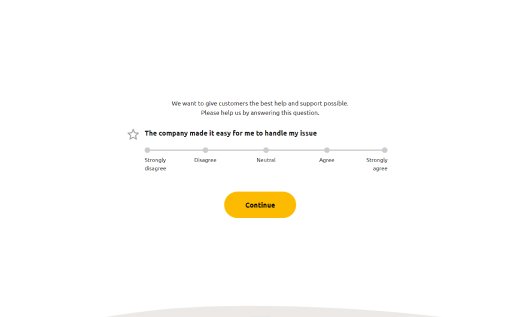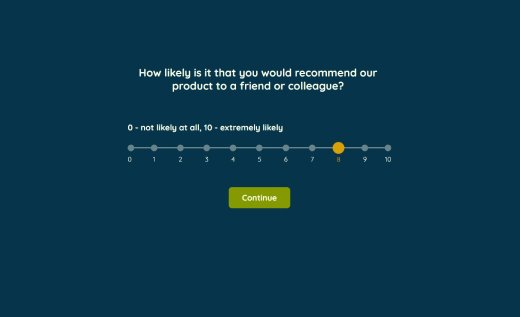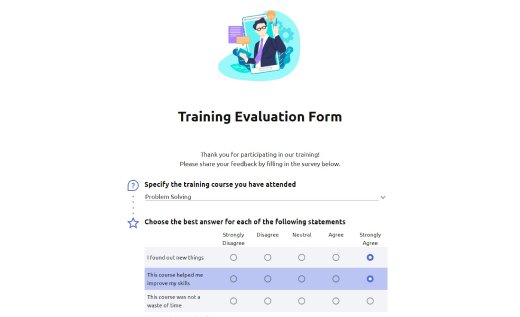What is a Likert Scale?

Learn about different types of Likert Scale and how to create them in the right way.
Learn why the 5-Point Likert Scale is the most popular.
Get Likert scale examples that are created in the AidaForm Survey Builder. Create your own Likert scales using ready-made survey fields or customize one of the 20+ questionnaire templates from AidaForm.
The definition of the Likert Scale
The Likert Scale is a type of rating scale used in questionnaires to measure people’s attitudes and opinions. It is named after its inventor, psychologist Renis Likert, who devised the approach in 1932. Respondents choose from a range of possible responses expressing their level of agreement or disagreement with the specified statement.
Likert Scale Example A: 5 - Point Likert Scale
Please rate the extent to which you agree/disagree with the following:
“TV campaigns are a good way to persuade people to stop smoking in the presence of children”
Likert Scale Example B: 7 - Point Likert Scale
Please rate the extent to which you agree/disagree with the following:
“TV campaigns are a good way to persuade people to stop smoking in the presence of children”
1 – Strongly disagree, 2 – Disagree, 3 – Somewhat disagree, 4 – Neither agree nor disagree, 5 – Somewhat agree, 6 – Agree, 7 – Strongly agree
Surveys with Likert Scales
Different Types of Likert Scale
The Likert Scale doesn’t have to state “agree” or “disagree”; dozens of variations are possible on themes like agreement, frequency, quality, and importance. For example:
- Frequency: Never – Rarely – Sometimes – Always – Often
- Quality: Poor – Fair – Good – Very good – Excellent
- Likelihood: Extremely Unlikely – Unlikely – Neutral – Likely – Extremely Likely
- Importance: Not at all important – Low importance – Slightly important – Neutral – Moderately important – Very important – Extremely important
These labels are called Likert Scale Response Anchors.
Note that some of the scales also have their own names like Frequency Scales or Semantic Differential Scale. See the complete list of types of rating scales that you will be able to create with the help of the AidaForm service.
Likert Scale Example C: Likelihood Likert Scale
How likely are you to recommend…
1 - Extremely likely, 4 - Neutral, 7 - Extremely unlikely
Likert Scale Example D: Frequency Likert Scale
When purchasing electronic products, how often do you do the following?
Examples with Different Types of Likert Scales
Does Size Matter? 5-Point Likert Scale or 7-Point Likert Scale?
The size of a Likert scale may vary, but scales with odd numbers of points prevail as they can have a midpoint (neutral answer). An even number of labels, as in a 4-point or 6-point Likert scale, make respondents choose strictly between “for” or “against”.
Most commonly, survey specialists use a 5-point scale (see examples A, B, D). A larger scale, for example, a 7-point scale, could offer more choices to respondents, but it has been noticed that the larger the scale, the more people tend to avoid labels for the extreme notions. Also, take into consideration that both rating scales with a big and small number of labels may cause difficulties because they provide too much or too little differentiation between points.
How to Make Your Likert Scale Survey More Effective
Keep it one characteristic per question:
Define and keep to the focus:
Likert Scale Example E: Focus on the quality of food and beverages
How satisfied or dissatisfied are you with the quality of …
1 - Not satisfied at all, 3 - Neutral, 5 - Completely satisfied, N/A - Not applicable
Use the Example to Create My Form
Analyzing the results of the Likert Scale Survey
Likert-type scales can be scored in different ways. It’s a common practice to score each item so that higher scores would indicate “more” of some characteristic and then take the average of all of the items. Note that the numbers will not have any inherent meaning. For example, if you are measuring attitudes towards politicians, scoring a 3.4 actually means that, on average, an individual was slightly favorable in his/her attitudes and can then be compared to the distribution of the remaining responses. Read our article which shows how using the wrong interpretation techniques helps manipulate polls results How Likert Scales Helped Vladimir Putin’s Rating
Likert-Type Scale Response Anchors
Don’t hesitate to download and consult the list of Likert-Type Scale Response Anchors here.
Let’s wrap it up with theory for now. It’s time to create and conduct polls and surveys. AidaForm is a cloud-based service allowing you to create online polls and surveys. Give it a try right away. And best wishes with your research!
AidaForm is a complete online service where you can create forms, share them, gather responses, and evaluate them in your member’s area.



